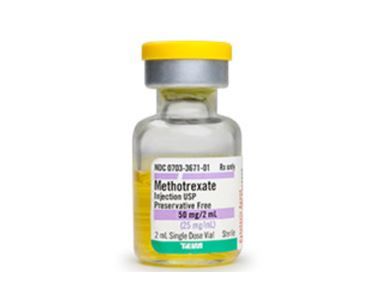Article
Try Subcutaneous Methotrexate First Before Biologic
An editorial in today's issue of Rheumatology makes a strong case for trying subcutaneous methotrexate first before a biologic.
(Methotrexate subcutaneous, photo courtesy of ©Teva Generics)

An editorial in today's issue of Rheumatology makes a strong case for first trying subcutaneous methotrexate before moving on to biologic drugs for the treatment of rheumatoid arthritis. Current practice dictates that patients who have tried and failed methotrexate plus another disease modifying anti-rheumatic drug (DMARD) therapy should be considered for biologic therapies.
Koduri GM et al. argued that this strategy misses an important window of opportunity in the first three months after onset of symptoms to alter the disease course by trying the less effective therapies first.
Oral methotrexate is a standard of care, although subcutaneous methotrexate delivers greater efficacy at the same dose and may be the best therapeutic choice for up to a third of rheumatoid arthritis patients, they claimed. Braun J. et al. wrote in 2008, that subcutaneous delivery has been shown to consistently produce higher peak plasma concentrations compared to oral dosing, which was supported by clinical trials in which efficacy of weekly subcutaneous injections of methotrexate (15 mg) was superior at 24 weeks.
This difference becomes especially significant, they suggested, in light of recognized delays in treatment in which an estimated third of all patients wait more than six weeks following their initial visit to begin any therapy for rheumatoid arthritis. Koduri GM et al. contended that, given the small window in which to affect long-term outcomes, “it may not make pharmacokinetic sense to use oral administration, which is less predictable in drug delivery.”
Switching to subcutaneous methotrexate following failure of oral therapy could expand the range of patients who achieve early remission, preventing the need for biologic drugs and resulting in significant costs savings per patient, they argued. Their recommendation was that subcutaneous methotrexate at 15 mg/week be given as a first-line therapy for rheumatoid arthritis, with rapid escalation to 20 mg/week in patients without active infection or significant immune deficiency.
REFERENCES
Koduri GM, Mukhtyar C. Why subcutaneous methotrexate should be a prerequisite to biologic use in patients with rheumatoid arthritis. Rheumatology (Oxford). 2019;58:559-560. doi: 10.1093/rheumatology/key097.
Braun J, Kästner P, Flaxenberg P, et al. Comparison of the clinical efficacy and safety of subcutaneous versus oral administration of methotrexate in patients with active rheumatoid arthritis: results of a six-month, multicenter, randomized, double-blind, controlled, phase IV trial. Arthritis Rheum 2008;58:73-81. doi: 10.1002/art.23144.




